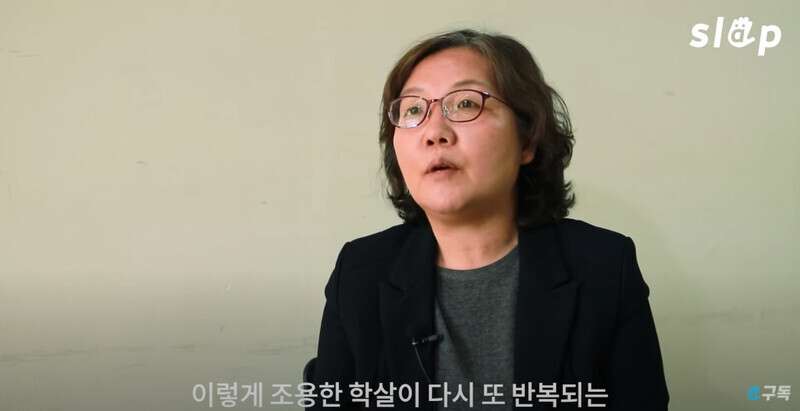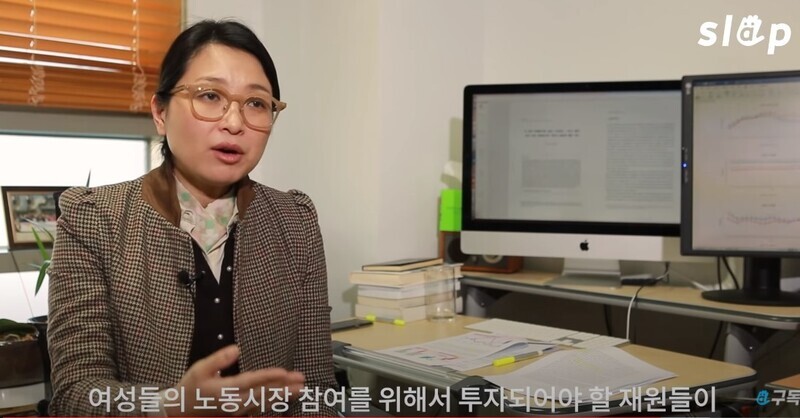hankyoreh
Links to other country sites 다른 나라 사이트 링크
Why are increasing numbers of young Korean women taking their lives?

The number of South Korean women in their 20s who are taking their own lives has been rising at an unprecedented rate.
Last year, the suicide rate among women in their 20s rose by 25.5% from the year before; between January and August 2020, women in their 20s represented the largest proportion of all suicide attempts at 32.1%. While the suicide rate for males is still roughly two to three times higher than that of women overall, the increase in the rate for women in their 20s far exceeds those of other generations and genders.
A video titled “A ‘silent massacre’ has begun again,’” which was released on Nov. 12 by the gender equality media outlet Slap, poses the question of why South Korean women born in the 1990s are taking their own lives, while showing the reasons South Korean society needs to respond to this “silent massacre.”
[Link to Slap’s YouTube channel: https://bit.ly/3pq8Jg0 <(Korean only)>]
Slap interviewed Jang Sook-rang, a Chung-Ang University professor of nursing who explained that her own research findings published in 2019 on the issue of suicide among young women showed the pattern of increase in the suicide rate among women in their 20s to resemble the postwar generation in Japan (born between 1902 and 1920) following the experience of World War II.
“The younger generation that had fought in the war during the imperialism era and the young people who had to weather the collapse of the state continued to suffer from depression and exhibited high suicide death rates [throughout their lives]. We call that a cohort effect,” Jang explained, using a term for a population sharing a particular pattern of behavior.
“I thought we might be seeing the same kind of cohort effect in South Korea, among young people in their 20s and 30s,” she added.
Young S. Koreans’ similarities with Japan’s postwar generationJang focused in particular on the suicide rate of women born in 1996, which was seven times higher than that of women born in 1956.
“Even among those born in the 1990s, the suicide rate rises with birth years later in the decade,” she said. “In comparison with the [women] born in the 1950s who represent the mothers of those born in the 1980s, the rate for those born in the 1980s is nearly five times higher, and for the 1990s it’s around seven times higher.”
“This ultimately means that the kind of living conditions that drive someone to suicide in their 20s have quintupled for the daughters in comparison with the mothers,” she added.
The conclusion is that the lives of young South Koreans today — especially women in their twenties — have been plagued by the sorts of scars that the Japanese postwar generation experienced through an actual wartime situation.

Analyzing the factors behind the sharp rise in the suicide rate for women in their 20s, Im Yoon-ok, an advisory committee member for the Korean Women Workers’ Association, said, “In South Korean society, male workers have performed the key staffing roles, while women have been used as surplus staff, employed when needed for supplementary work but always expendable when they aren’t needed.”
“So women have ended up mainly in service jobs, and since the service industry has suffered the biggest blow from the COVID-19 situation, women in their 20s have also been hit the hardest,” she said.
According to a Korean Women's Development Institute (KWDI) analysis of trends in women’s employment in September, the unemployment rate for women stood at 3.4%, an increase of 0.6% from the same month in 2019. The unemployment rate for women in their 20s was highest at 7.6%.
Im argued that South Korean society’s silence in the face of this unemployment among young people — already in a vulnerable position in the labor market — has brought about a “silent massacre.”
“In March alone, 120,000 women in their 20s lost their jobs. Overwhelmingly. Yet people were quiet. Yet even though this silent massacre is repeating itself, it seems to be that the way South Korean society has responded to the crisis has been extremely patriarchal,” she said.
Chung Hae-joo, a professor at the Korea University Division of Health Policy and Management, said the question of whether women are recognized as “equal members” of the labor market may have an impact that extends to the suicide rate.
“We’re in a situation where the university matriculation rate [for women] is 8% higher than for men. This aspect isn’t getting translated into social status, including standing within the labor market,” she said. “That’s the position South Korean women are in.”
Rate of labor market participation an important factorChung cited the example of Europe.
“Ultimately, one of the factors that most strongly influences suicide among young people [in Europe] is women’s rate of labor market participation,” she said.
“It helps to reduce male and female suicide rates in places like South Korea and Europe when women are considered equal members of society rather than ‘women within the home,’ and when they are made in labor market participants who join in supporting efforts for society’s advancement.”
Chung also shared European research findings showing a tendency for suicide rates among young women to rise with higher levels of support for family policies.
“It’s really surprising. These are policies with things like child allowances to contribute to development through support for families, but they aren’t helpful at all to people who aren’t actually starting families or don’t intend to,” she said.
The argument is that policy-based support measures designed from a family-focused perspective have not been reaching young women seeking to live as independent individuals within the labor market — and that as these young women are left out of policy support measures, the result has been an increase in suicide rates.
A similar view was shared in a report on “male-female differences in life prospects for the young generation and root causes of low birth rates” published on Oct. 31 by KWDI. “Young people no longer believe that the marriage system can serve as a foundation for survival throughout one’s lifetime,” it said. “Young women are making the desperate choice to continue a work-centered life throughout their lifetime.”
According to this analysis, support policy measures premised on marriage and child raising will inevitably result in gaps for young women as individuals design their own lives centering on their profession or career.
The video posted by Slap on YouTube attracted around 200 replies, many of them sharing their support and calling the situation “heartbreaking.”
“As someone born in the 1990s, it’s been heartbreaking for me to see my peers experiencing the same kind of suffering,” one viewer wrote.
“Jobs are one thing, but there’s also been a kind of learned helplessness that arises with all our experiences with misogynistic culture and discrimination from a young age within a patriarchal society, and I think that as [women] experience major frustrations in the labor markets at adults, that is leading them to suicide,” another said.
“I want this to be a world where people my age don’t want to die. Rather than just watching this happening, I intend to do what I can as an individual, and I hope everyone else who watched this video will do the same,” a third wrote.
By Lim Jae-woo, staff reporter
Please direct comments or questions to [english@hani.co.kr]

Editorial・opinion
![[Editorial] Intensifying US-China rivalry means Seoul must address uncertainty with Beijing sooner than later [Editorial] Intensifying US-China rivalry means Seoul must address uncertainty with Beijing sooner than later](https://flexible.img.hani.co.kr/flexible/normal/500/300/imgdb/original/2024/0517/8117159322045222.jpg) [Editorial] Intensifying US-China rivalry means Seoul must address uncertainty with Beijing sooner than later
[Editorial] Intensifying US-China rivalry means Seoul must address uncertainty with Beijing sooner than later![[Column] When ‘fairness’ means hate and violence [Column] When ‘fairness’ means hate and violence](https://flexible.img.hani.co.kr/flexible/normal/500/300/imgdb/original/2024/0516/7417158465908824.jpg) [Column] When ‘fairness’ means hate and violence
[Column] When ‘fairness’ means hate and violence- [Editorial] Yoon must stop abusing authority to shield himself from investigation
- [Column] US troop withdrawal from Korea could be the Acheson Line all over
- [Column] How to win back readers who’ve turned to YouTube for news
- [Column] Welcome to the president’s pity party
- [Editorial] Korea must respond firmly to Japan’s attempt to usurp Line
- [Editorial] Transfers of prosecutors investigating Korea’s first lady send chilling message
- [Column] Will Seoul’s ties with Moscow really recover on their own?
- [Column] Samsung’s ‘lost decade’ and Lee Jae-yong’s mismatched chopsticks
Most viewed articles
- 1[Editorial] Transfers of prosecutors investigating Korea’s first lady send chilling message
- 2[Exclusive] Unearthed memo suggests Gwangju Uprising missing may have been cremated
- 3[Editorial] Intensifying US-China rivalry means Seoul must address uncertainty with Beijing sooner t
- 4S. Korea “monitoring developments” after report of secret Chinese police station in Seoul
- 5[Column] US troop withdrawal from Korea could be the Acheson Line all over
- 6Could Korea’s Naver lose control of Line to Japan?
- 7Xi, Putin ‘oppose acts of military intimidation’ against N. Korea by US in joint statement
- 8‘Shot, stabbed, piled on a truck’: Mystery of missing dead at Gwangju Prison
- 9Korea’s first openly trans athlete hopes to prompt a discussion by competing as herself
- 10Korea poised to overtake Taiwan as world’s No. 2 chip producer by 2032